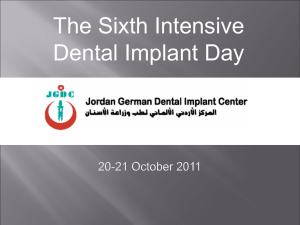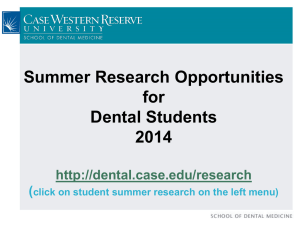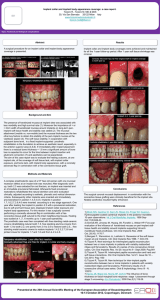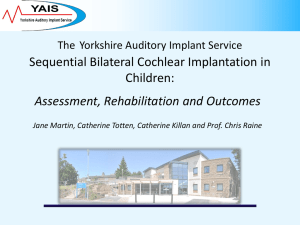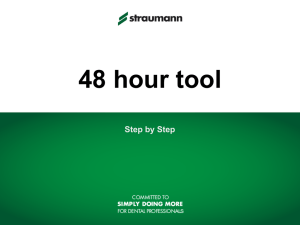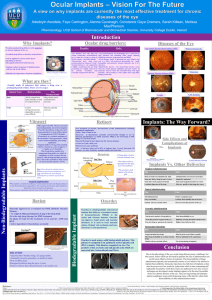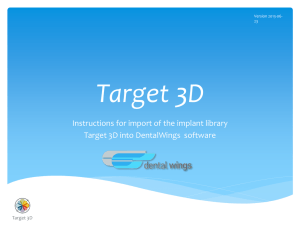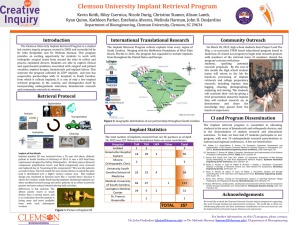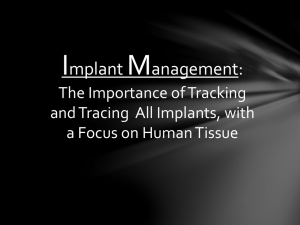Current Concepts in Occlusion and TMD
advertisement
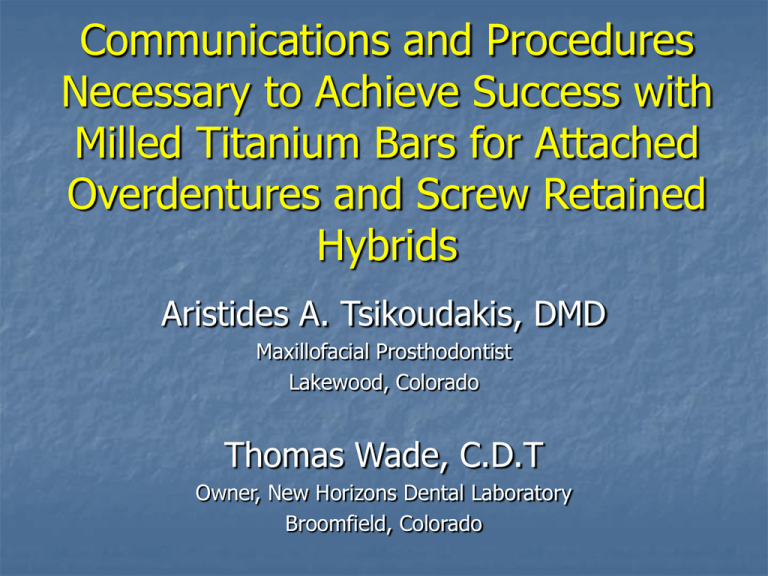
Communications and Procedures Necessary to Achieve Success with Milled Titanium Bars for Attached Overdentures and Screw Retained Hybrids Aristides A. Tsikoudakis, DMD Maxillofacial Prosthodontist Lakewood, Colorado Thomas Wade, C.D.T Owner, New Horizons Dental Laboratory Broomfield, Colorado Objectives Review of fundamentals Initial exam and work up Diagnosis Patient expectations Classification of Prostheses Implant supported Implant assisted Case presentation Detailed examination of restorative and lab components Initial Exam Critical Elements Extra-oral: TMJ Neck Soft Tissues Initial Exam Intra-oral: Soft Tissues Charting Edentulous evaluation Initial Exam Radiographic Examination Orthopantogram Vs. Tomogram Initial Exam Diagnostic Casts Impressions Jaw relation records Facebow Mounting Tooth selection Initial Exam Diagnostic Casts If patients existing dentures have adequate form and function then… Denture Information Transfer Initial Exam Diagnostic Set-Up Chairside arrangement of anterior teeth Midline Labial contour (lip support) Smile line Tooth display Phonetics Initial Exam Lab Hints: Set-up wax Positioning technique Adjusting existing set-up Photos are always welcome Casts of existing prostheses Initial Exam Diagnosis: Pathology Edentulous Degree of resorption Intact alveolar volume, missing clinical crown Deficient alveolar/soft tissue volume Skeletal-occlusal relationship Initial exam Establishing Patient Expectations Listen Interpret Confirm Classification Implant Supported Forces are borne entirely by the implants without support from the soft tissue Implant Assisted Support is shared between implants and soft tissue Clinical Steps Number of Visits: 6-8 Preliminary impressions Verification and master impressions Ant set-up and jaw records Wax try-in Substructure try-in Clinical remount & delivery 1:00 2:00 1:00 1:00 1:00 1:30 Objectives Photo Montage… Guided surgery All-0n-4 Radiographic guides Milled titanium bars Troubleshooting common problems Accurate impressions and proper casts Information & communication Treatment planning Collaboration between surgeon, restorative, lab Troubleshooting “If you don’t have time to do it correctly the first time… When are you going to have time to do it over?” Troubleshooting Accurate impressions: sets level of excellence Custom tray when indicated Adhesive (PVS & Alginate) Proper proportions (alginate & polysulfide) Read it Retake if necessary Troubleshooting Casts Properly poured and based casts Heels Avoid mandibular horseshoe casts Inspect prior to sending to lab (pack properly) Selection of appropriate gypsum Plaster: never Die stone: splints, implants, RPD Stone: everything else Troubleshooting Information and Communication Case info: more is ALWAYS better than not enough gender age shade, opposing cast, jaw record photos (important for tooth selection) accurate extraction info cast of existing prostheses Troubleshooting Relines and adding teeth/clasp to RPD: Pick-up impression Alginate vs. PVS Proper pouring technique Treatment Planning Collaborative Effort Surgeon Restorative Dr. Lab technician Treatment Planning Goal: To devise the most predictable and straight forward approach for meeting the patient’s expectations Essentially comes down to 2 factors: Patient expectations Bone: where and how much Treatment Planning Cases: Implant Supported Fixed vs. Removable Component stacking phenomenon Minimum dimensions Metal-ceramic 4.5 to 5mm Fixed hybrid 9mm Removable 16mm Treatment Planning Decisions: Implant supported vs. Assisted Selected by patient Fixed vs. Removable Depends on: Defect Interocclusal space * Surgery: modify existing anatomy Treatment Planning Once a treatment plan has been devised… What criteria are used to select appropriate implant system? What about radiographic/surgical guide? Treatment Planning Implant system selection criteria: Splinted vs. non-splinted Angled implant placement Guided implant placement Treatment Planning Radiographic / Surgical Guides Treatment Planning Radiographic / Surgical Guides 10o Treatment Planning Guidelines: Determine visibility of the residual ridge Presence or absence of composite defect Biomechanics (force control) Bedrossian et al. Implant restoration of the edentulous maxilla: a systematic pretreatment evaluation method. J. Oral Maxillofac Surg 66:112-122, 2008 Treatment Planning Implant Supported vs. Implant Assisted Transition Composite Defect Interocclusal Space yes no yes no 5-8 mm 9+ mm 16+ mm PFM OD Surgery PFM OD SRH SRH OD PFM PFM SRH OD *Surgical modification Treatment Planning Guidelines: Biomechanics (force control) Reduce forces applied to system Engineer system to withstand forces Treatment Planning Guidelines: Biomechanics (force control) Bone in premaxilla, premolar and molar area: conventional implant placement greatest A-P spread possible Treatment Planning Guidelines: Biomechanics (force control) Bone in premaxilla and bicuspid only: Angled implants Sinus graft Treatment Planning Guidelines: Biomechanics (force control) Bone in premaxilla only: Sinus graft Zygomatic implant Implants in cuspid sites Treatment Planning Guidelines: Biomechanics (force control) Bone deficient in all zones: Zygomatic implants x 4 Treatment Planning Guidelines: Biomechanics (force control) Minimize cantilever of substructure Stress relieving design for implant assisted Proper material thickness Reinforcement as needed Treatment Planning Guidelines: Biomechanics (force control) Reinforcement Stress relieving ? Treatment Planning Attachment: Criteria for selection Implant Supported: Only needed for retention Minimal height Easy & inexpensive to replace insert Readily available Minimize wear between components Treatment Planning Attachment: Criteria for selection Implant Assisted: Retention Minimal height Easy & inexpensive to replace insert Readily available Minimize wear between components Resilient Allows for rotation Treatment Planning Establishing Fees 3-4 x lab cost to Dr. Dental Fee Analyzer Chairtime Treatment Planning Establishing Fees Ranges Maxillary PFM (8) SRH (8) SRH (4) OD w/Bar (4) $19,100-$27,300 $15,000-$21,400 $13,600-$19,500 $7,000-$10,000 Mandibular PFM (6) SRH (6) SRH (4) OD w/Bar (4) OD w/Bar (2) $17,700-$25,300 $14,200-$20,400 $13,600-$19,500 $7,000-$10,000 $5,600-$8,000 Treatment Planning Questions? Lakewooddentalimplants.com

